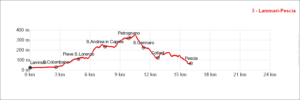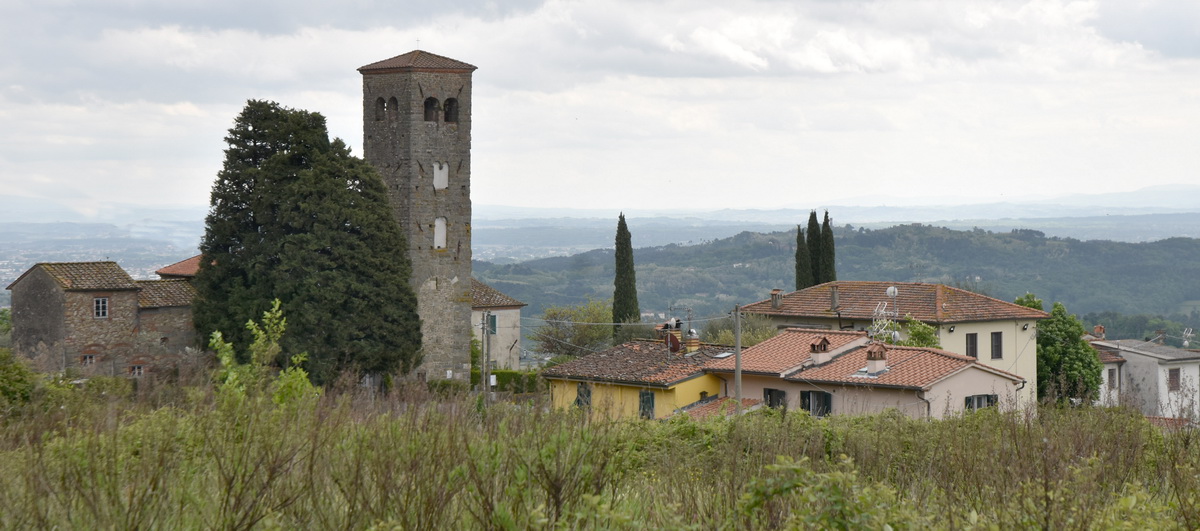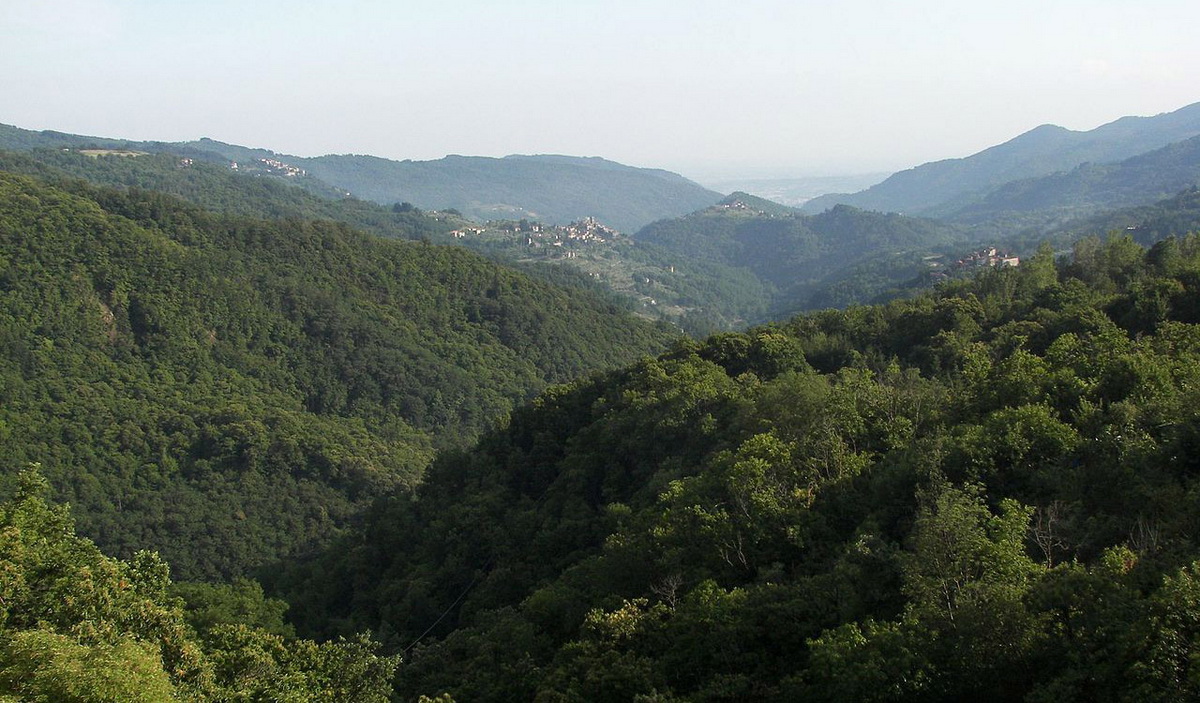Stage 3 – Lammari / Pescia
FIRST HALF STAGE – From Lammari to Petrognano – km 10,0
We cross the Lucca plain until we reach the foot of the hills. We leave the urbanized areas to immerse ourselves in green hills covered with vineyards, olive groves and woods. In the lower part we find some historic villas with beautiful gardens. We cross small villages touching the highest point of the half stage in the village of Petrognano
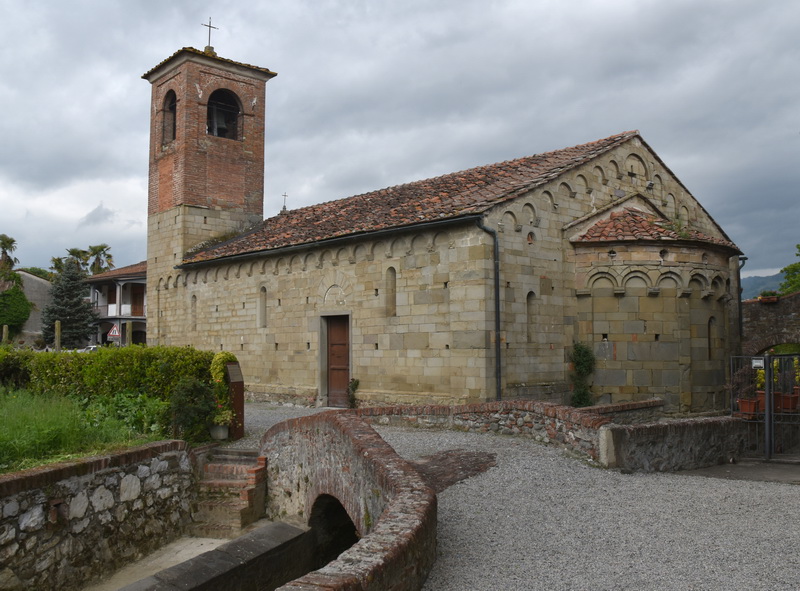
We begin our journey from the square of the church of Lammari (km 0,0) taking via dei Leri; we bend to the right paying attention because after 170 meters we have to turn left onto a wide road (it looks like a parking lot): at the end we turn to the right and then to the left. We thus arrive at the ancient Romanesque church of San Cristoforo which we reach by taking a small road to the right that runs alongside a ditch and past the ancient wash house. The church is worth a short visit. We go around the church and follow a dirt road which, following the path of a ditch, pleasantly crosses a field ending in an asphalted road (via delle Ville) which we follow to the right. In this section we must be careful because the road is busy and there are no footpaths!!! We arrive near an important road junction with traffic light where there is no pedestrian crossing: once we reach a shopping center [there is a square with several parking lots] we have to turn right until we reach Viale Europa (SP26 ) which we cross then turning to the left until we reach the intersection. From here we resume Via delle Ville remaining, for the first stretch, on the left side of the road: after 300 meters we move to the right side because a narrow cycle path begins.
We arrive at the village of San Colombano (km 2.6) at the height of a large road junction and continue on the right (Tamoil petrol station) until we reach a small grassy play area with trees: at this point we cross the road and leave it, following via della Quarquonia which begins to rise slightly taking us to the foot of the hill. We continue on the left following a canal path: we turn right a few meters before reaching a busy road. (km 3,2)
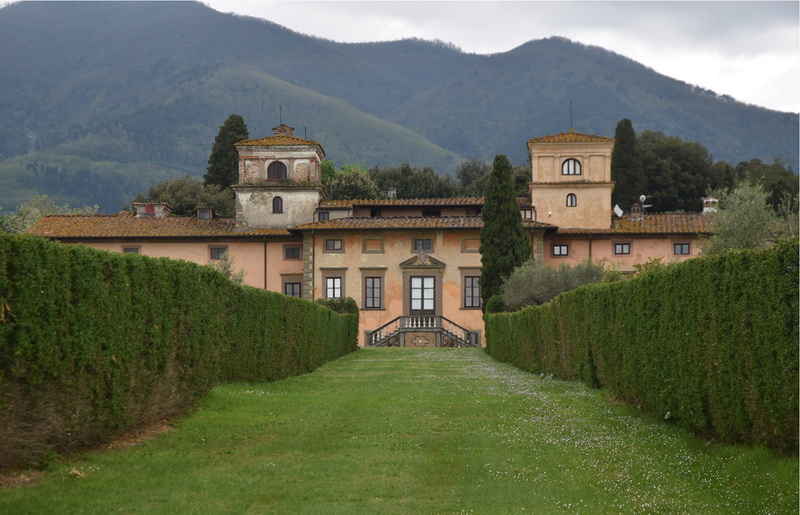
We are at an important point because we finally abandon the highly built-up area starting to walk in the gentle hills of Lucca, skirting several ancient villas.
We begin to climb along a paved road first in the woods, then among beautiful olive groves: in the background we see the sixteenth-century Villa del Vescovo. Arriving in front of its entrance gate, we follow the enclosing wall to the right, running alongside some farmhouses. The road becomes a dirt road: we pass a farm with two large geese (Ulysses and Caterina) acting as guard and then go up among olive groves until we come out in via delle Selvette at the height of a large Cross of the Passion. In this part of the journey our route coincides exactly with the “Tour of the Villas” marked with metal signs with a brown background indicating the names of the individual villas to visit. We continue to the right for 150 meters and then we turn to the right again on a gently rising road among olive groves. At the height of some farmhouses the road becomes unpaved and with a left turn continues with ancient cobblestone and stone walls on the sides, and climbs up through olive groves, flowing again on via delle Selvette which we follow to the right arriving at the village of Pieve San Lorenzo (km 5,5) dominated by a large church and tall bell tower.
We continue uphill to the left on via Segromigno in Monte, then turn right at the first narrow road that slips between the houses (signposted S. Pietro a Marcigliano), exits the village and descends to a bridge to then resume climbing steeply in a straight line. In this section our route coincides with the CAI path n. 13. Arrived at the height of a strongly inclined gateway, we leave the road and take a path that continues to climb straight and then flattens.
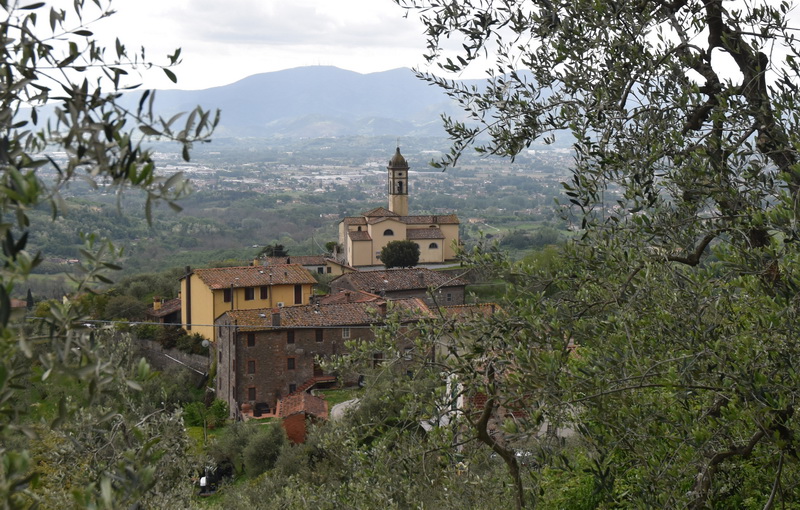
We pay attention because here we have to abandon the signs of the CAI path n. 13 and take a branch of the path to the right that takes us back to the paved road. From this point we begin to enjoy a panoramic view over the Lucca plain, Monte Pisano and the Camaiore hills. We follow the road for 200 meters and then we take a dirt road on the right that goes down to a canal and we cross over a stone bridge. We go up in the woods to two dilapidated houses and we climb again among olive groves and vineyards: in front of us the bell tower of the church of Sant’Andrea in Caprile (km 7,5) where we arrive alongside some houses (don’t worry, you are not entering a private area ).
From below the church square we continue on the left following the road towards Tofori. We arrive in this village after walking for a kilometer in light ups and downs: turning our gaze to the right we can always see the church of Santa Maria Assunta located at the top of a hill away from the town. Arrived at the crossroads we choose the road that climbs to the left and that takes us, with a moderate climb, up to Petrognano. A shortcut, still in the town of Tofori, cuts to the right avoiding a long bend. We pass next to the ancient Gambaro Farm (possibility of refreshment and accommodation) and then we arrive at the village of Petrognano dominated by the church of San Pietro Apostolo (km 10,0)
SECOND HALF STAGE – From Petrognano to Pescia – km 6,2
We go down among very wide panoramas to the village of San Gennaro and then to Collodi: the Via delle Fiabe takes us to Pescia
We skirt the church going down a small road to resume the asphalted road that we follow for 500 meters reaching the highest point of today’s stage. From here, after a curve, we take a path to the right and begin to descend a steep slope, finally coming to an asphalted road: a little further on we take a road on the right that crosses the village of San Gennaro from top to bottom (km 11.4) . We encounter elegant villas with manicured gardens, ancient buildings, cobbled streets. Arrived at a square with parking, we leave the town. At the next crossroads we continue flat to the left up to the cemetery. From here we go down to the right along the road that leads to Collodi. We will avoid going along the asphalt with two shortcuts on the path: we find the first 300 meters after an intersection (let’s go left). Further down we reach the asphalted road, cross it and take the second shortcut which on a paved surface leads us to the first houses of Collodi (km 12.8): on the left we see the large villa Garzoni and the ancient village above. Finally, we arrive in front of the entrance to the Pinocchio park. We go down to the square fearing us on the right and following the tourist kiosks.
Arriving at a pedestrian crossing, we cross the road and follow the wall going up to the right: at the beginning there is an high iron cross of the passion. We go up along an ancient and beautiful paved road flanked by stone walls and dominated by dense vegetation. At a fork the road on the left climbs to the village of Collodi; we continue to the right on a path called “Via della Fiaba”: frequent signs remind us of this. The road generally descends, but there are a few climbs, we cross Via di Collecchio, after which we arrive at the first houses of Pescia (km 16.2). We descend along via Sismondi arriving at Piazza Matteotti. Here we turn left and, following via Libero Andreotti and Borgo della Vittoria, we arrive at the central square Mazzini, narrow and long: at the end, the ancient Vicar’s palace, now the Town Hall.
servicies
PETROGNANO
Fattoria di Petrognano – Petrognano – tel. 338 1255359 (talk to Carla) – Rooms with bathroom or rustic apartments with kitchen 25 euros per person 15 euros pilgrim’s menu – Reservation recommended
MONTE A PESCIA (2,1 km da Pescia)
Agriostello Vipiana -hostel-like hospitality in a renovated farmhouse, simple and welcoming environment, splendid view, 30 beds, suitable place for groups – societaagricolavipiana@gmail.com, https://www.poderevipiana.it/ – Francesco 328 824 6943 – dinner, bed and breakfast € 65
PESCIA
Pilgrim Hospitality – a structure for the hospitality of pilgrims is being prepared in the heart of the town, it will be our responsability to provide more information as soon as possible.
La Magione, managed by the Officina delle Arti, is a welcome and information point for pilgrims. It is located in via Santa Maria, 2 in the heart of the historic center of Pescia and is open every Tuesday, Wednesday, Friday and Saturday from 10 to 13 and from 15 to 18. You can call at any time at 349 6291542 (Nicola) and you will receive an answer at every need.
Hospitalty in a family – the pilgrim Noemi Sembranti makes two beds available in her home, as a donation, with the foresight to contact her in advance and check availability tel. 333.4745031
Agriturismo Villa Olivi (1 km before Pescia, 300 m from the path), Via di Collecchio 9 – tel. 331.4007173 – double room from 50 €, quadruple room 80 €. Others accomodations at a price to be agreed – villacolleolivi@outlook.it
Dimora Elsa apartments (0.4 km from the Duomo) Via Libero Andreotti, 34 – Pescia – tel. 392 6608951 (Teresa) Apartments consisting of double bedroom, bedroom with two beds, living room with sofa bed and kitchen
Villa delle Rose / Piazza Grande Restaurant (2.5 km from the Duomo, near the station) – Via del Castellare, 21 Pescia – tel. 0572 4670 – villarose@rphotels.com – Hotel in historic villa with garden and summer swimming pool
Arcobaleno Toscano (0.1 km from the Duomo) Piazza Don Giovanni Minzoni, 6 tel. 335 6274181 (Amerigo) – amerigotiti@aliceposta.it Two-room apartments equipped with all comforts and kitchen
Camigliano Santa Gemma – Segromigno in Piano
Bus line E6 CTT Lucca – Vaibus for Lunata and onwards to Pescia – stop nearby.
Collodi
Bus line E6 CTT Lucca – Vaibus from Lucca to Pescia.
Blubus Copit Pistoia – urban line U03 Pescia – Ponte all’Abate – Collodi.
Pescia
Trenitalia – Pistoia – Lucca – Pisa line.
Blubus Copit Pistoia – urban line U03 Pescia – Ponte all’Abate – Collodi.
Blubus Copit Pistoia – line 73 Pescia – Montecatini Terme – Monsummano.
Bus line E6 CTT Lucca – Vaibus for Lucca.
Taxi – parking on the square in front of the train station.
Pharmacies: Pescia
Hospitals: Pescia
Bar: San Colombano, Petrognano Farm, Collodi, Pescia
Restaurants: San Colombano, Petrognano Farm, Collodi, Pescia
Bank: Collodi, Pescia
Post Office: San Colombano, Sant’Andrea in Caprile, Collodi, Pescia
Railway Station: Pescia
Sports equipment: Pescia
Food and Supermarket: San Colombano, Collodi, Pescia
Mechanical assistance service for bicycles: Pescia
For the Lucca / Capannori area you can call Eleonora: 328.9076318
For the San Gennaro area you can contact Luciano Occhiochiuso, Via Menicucci 4, San Gennaro, tel. 342.1454246: on the house there is the “Casa del Blues” sign. He can give you a hand and, if possible, he can also host you in his home, with a pilgrim hostel as a donation – 342.1454246
For the Pescia area you can call Nicola: 349.6291542
places
This small hamlet takes its name from the Irish pilgrim monk who founded the monastery of Bobbio. Until the 11th century, numerous monks came from the British Isles to convert the pagan populations. Colombanus stands out among all of them, having arrived in the land of the Longobards, he was a great evangeliist and through various foundations located in various territories, contributed greatly to the spread of Irish monasticism in Europe.
The main points of interest are:
The Oratory of San Concordio di Rimortori – an ancient hospital formerly dependent on the parish church of San Lorenzo di Segromigno in Monte, built around 1122 and still visible in its original structure consisting of large blocks of squared stone.
The Church of San Colombano Alto – dates back to the 13th century and was modified in 1821 when the expansion to three naves began. The work proceeded very slowly as the manpower was provided by the parishioners themselves when they were not farming in the countryside. The Church has a panel painting depicting the Madonna and Child with Saints Anthony the Abbot, Colombano di Bobbio, Caterina d’Alessandria and San Sebastiano.
For more informations: www.santiebeati.it/dettaglio/30200
Here you will find the beautiful church built entirely of stone, with a single nave and apse. The façade has typical Romanesque arches, the stone portal with a decorated arch and the lunette with a fresco from 1735 (with the representation of the Madonna del Rosario between St. Peter and St. Andrew). Inside there are two paintings by Pietro Nocchi: the Sacred Heart and Saint Andrew. There is also a holy water stoup from 1592, the organ is from 1703 and the high altar is from 1769 by Carlo Antonio Vagli.
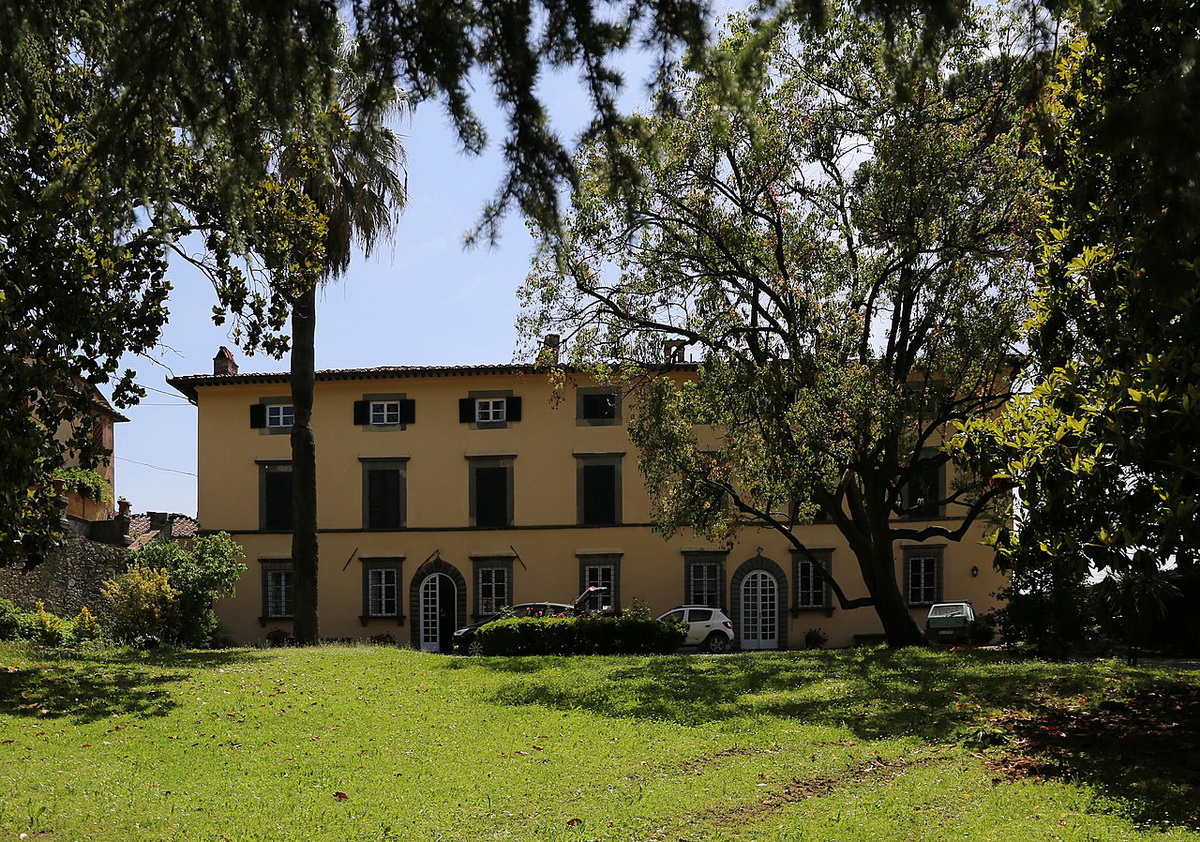
The small hamlet gathers a handful of houses and less than fifty inhabitants whose activity is historically agricultural and in particular in the cultivation of vines and olives. A place of peace, of wind full of sweet scents of the countryside.
Fattoria di Petrognano – It is an agricultural and hospitality complex that we meet among centuries-old cypress trees, vineyards and olive groves, in a panoramic position. Squirrels and hares as well as pheasants and woodland animals are easily encountered as this is a wildlife restocking area. The Petrognano Farm is a particularly prestigious winery as well as a producer of “Toscano delle Colline di Firenze” Extra Virgin Olive Oil with Protected Geographical Indication, obtained from the cold pressing of olives.
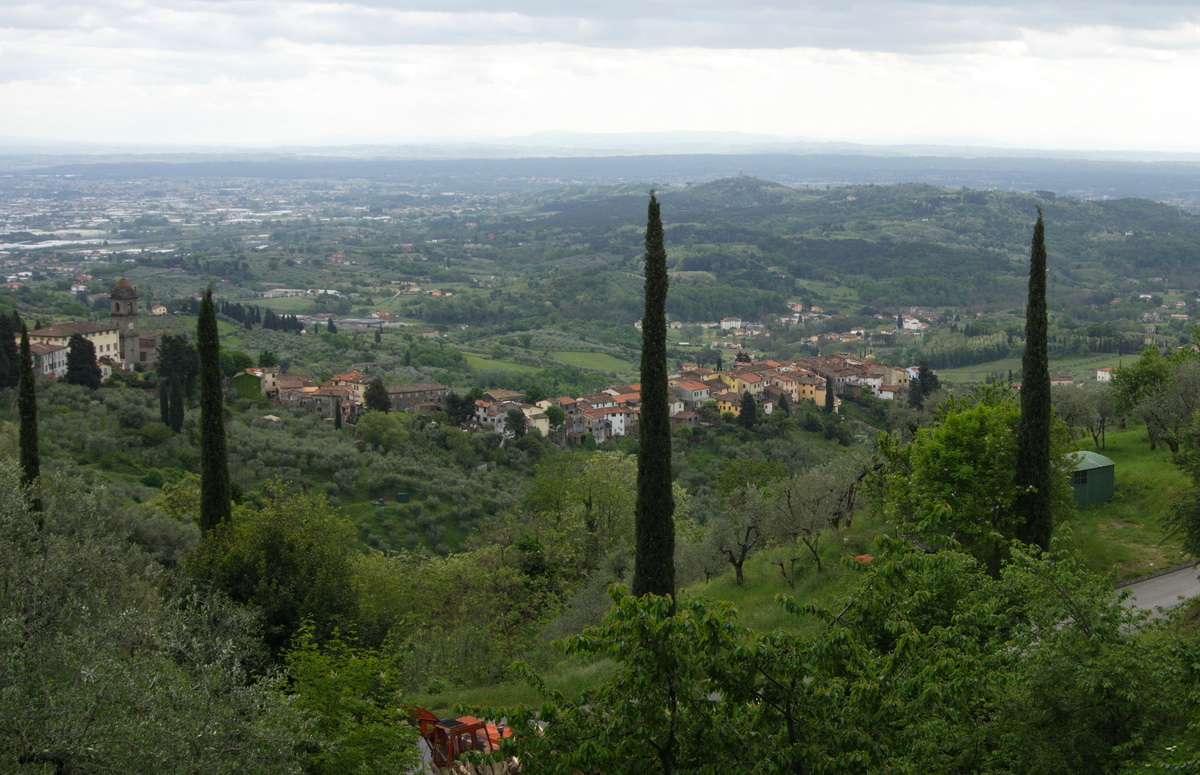 You come downhill to the first houses of the village of San Gennaro which immediately appears very well-kept, the paved streets and high walls protect the privacy of the beautiful villas. Ancient houses adorned with flowers, only the sound of our footsteps in the street. A bar and restaurant that, to underline the Neapolitan citizenship of the Saint, is called “the red horn”.
You come downhill to the first houses of the village of San Gennaro which immediately appears very well-kept, the paved streets and high walls protect the privacy of the beautiful villas. Ancient houses adorned with flowers, only the sound of our footsteps in the street. A bar and restaurant that, to underline the Neapolitan citizenship of the Saint, is called “the red horn”.
Let’s not forget to visit the ancient Pieve which has become famous in recent times for the attribution to Leonardo da Vinci of a terracotta statue kept inside the church, depicting the Archangel Gabriel. The scholar who advanced this attribution argues that Leonardo, at the time of his studies on the canalization of the Arno, may have stopped in San Gennaro. Traces of his visit are shown on the map, drawn up during the hydraulic engineering activity, which depicts both the church and the surrounding landscape.
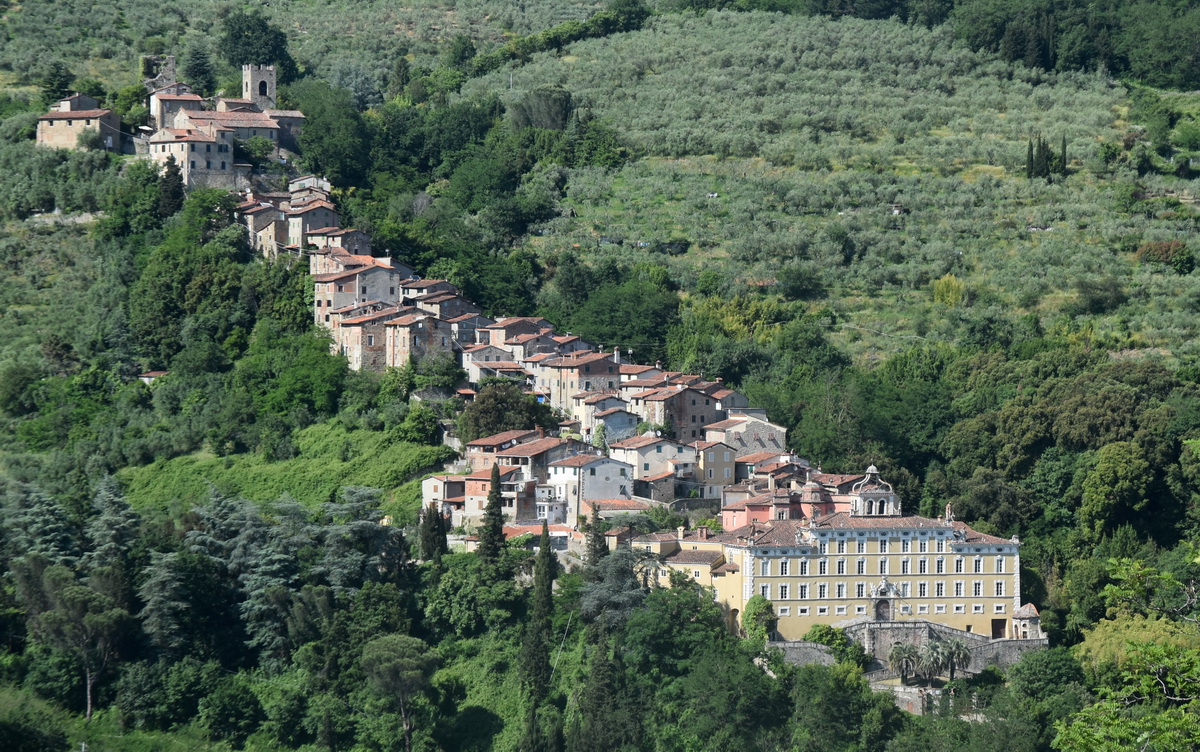 Approaching the village of Collodi, one goes to the memory of the perfume that had that booklet, given by a nice uncle, and to the story, full of strange characters, of the famous puppet. In memory they are all exaggerated, from the lantern hat of the carabinieri, to the fear that inspired the huge fire-eater, not to mention all those poor donkeys. Thus the image of the village, perched on the hill, with the houses that seem to seek shelter behind the large Villa Garzoni, seems to confirm the atmosphere of the fairy tale. The imagination helps us to imagine the unfolding of history in these narrow streets, Geppetto’s workshop seems to be hidden in that canton and the wood that will become his child will have collected it in that pile near the door of a house . The mother of Carlo Lorenzini, author of the book, was originally from this hamlet of Pescia. Which preserves the ancient fortress at the top and the majestic Villa Garzoni, built on the ruins of the ancient medieval castle. On the top of the village is the Pieve di San Bartolomeo, inside which important works of art are preserved. Villa Garzoni is a typical Lucca residence, which has remained unchanged over time. Lying on the hill, at the base of the stone houses of the town, the façade stands out majestically on the town, surrounded by the large garden, equipped with terraces, created due to the steep slope, and embellished with splendid flights of stairs, statues and fountains.
Approaching the village of Collodi, one goes to the memory of the perfume that had that booklet, given by a nice uncle, and to the story, full of strange characters, of the famous puppet. In memory they are all exaggerated, from the lantern hat of the carabinieri, to the fear that inspired the huge fire-eater, not to mention all those poor donkeys. Thus the image of the village, perched on the hill, with the houses that seem to seek shelter behind the large Villa Garzoni, seems to confirm the atmosphere of the fairy tale. The imagination helps us to imagine the unfolding of history in these narrow streets, Geppetto’s workshop seems to be hidden in that canton and the wood that will become his child will have collected it in that pile near the door of a house . The mother of Carlo Lorenzini, author of the book, was originally from this hamlet of Pescia. Which preserves the ancient fortress at the top and the majestic Villa Garzoni, built on the ruins of the ancient medieval castle. On the top of the village is the Pieve di San Bartolomeo, inside which important works of art are preserved. Villa Garzoni is a typical Lucca residence, which has remained unchanged over time. Lying on the hill, at the base of the stone houses of the town, the façade stands out majestically on the town, surrounded by the large garden, equipped with terraces, created due to the steep slope, and embellished with splendid flights of stairs, statues and fountains.
For the amusement of travelers and especially their children, the Monumental Park of Pinocchio was created, a sort of open-air museum, one of the main attractions of Collodi. It appears different from the usual amusement park, it is actually a path in which art and nature intertwine: in the grove of holm oaks that surrounds a square bordered by walls, different characters meet, the fairy, the carabiniere, the shark, created by great artists, in an atmosphere that recalls the echoes of the most loved fairy tale by young and old.
For more information: https://it.wikipedia.org/wiki/Collodi_(Pescia)
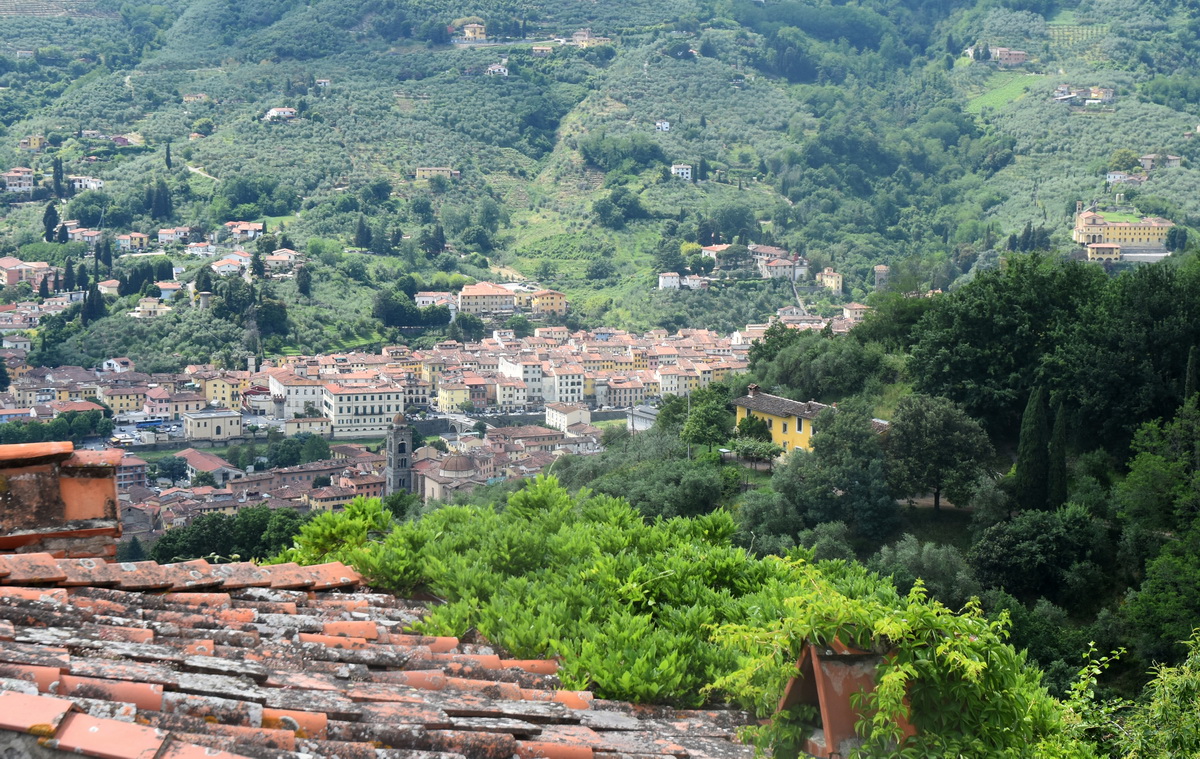 The town of Pescia, considered the capital of the Valdinievole, presents a curious clear distinction between the two parts of the village: the religious one with the Cathedral which originated from the Pieve di S. Maria and the civil one with the Palazzo Comunale and the large square which originated from the Pescia castle. It is divided by the river of the same name on which the Ponte del Duomo is located. Until 1339 it was a dominion of Lucca but it was conquered by the Florentines and since then it has remained under that jurisdiction. The main points of interest are the Cathedral (Duomo) with the fourteenth-century bell tower, the church of Santa Chiara and the convent of the Poor Clares with the ancient cloister, in Piazza Garzoni; the church of S. Maria Maddalena on whose altar is preserved the Crucifix known as “della Maddalena” dating back to the second half of the century. XIV. Since 1700, every twenty-five years, the crucifix has been transported through the streets of the city and on that occasion, called the “May Festival”, the buildings and hills are illuminated with wax candles. Near piazzetta Ducci the Palazzo of the Cecchi family is visible with an internal front porch characterized by Renaissance columns and capitals. The local economy, as well as tourism, is made up of nurseries of olive trees, citrus fruits, houseplants and the production of cut flowers, of which the area is a major exporter. The best known local celebration is the PALIO DEI RIONI, an archery competition with a colorful historical procession held every first Sunday in September.
The town of Pescia, considered the capital of the Valdinievole, presents a curious clear distinction between the two parts of the village: the religious one with the Cathedral which originated from the Pieve di S. Maria and the civil one with the Palazzo Comunale and the large square which originated from the Pescia castle. It is divided by the river of the same name on which the Ponte del Duomo is located. Until 1339 it was a dominion of Lucca but it was conquered by the Florentines and since then it has remained under that jurisdiction. The main points of interest are the Cathedral (Duomo) with the fourteenth-century bell tower, the church of Santa Chiara and the convent of the Poor Clares with the ancient cloister, in Piazza Garzoni; the church of S. Maria Maddalena on whose altar is preserved the Crucifix known as “della Maddalena” dating back to the second half of the century. XIV. Since 1700, every twenty-five years, the crucifix has been transported through the streets of the city and on that occasion, called the “May Festival”, the buildings and hills are illuminated with wax candles. Near piazzetta Ducci the Palazzo of the Cecchi family is visible with an internal front porch characterized by Renaissance columns and capitals. The local economy, as well as tourism, is made up of nurseries of olive trees, citrus fruits, houseplants and the production of cut flowers, of which the area is a major exporter. The best known local celebration is the PALIO DEI RIONI, an archery competition with a colorful historical procession held every first Sunday in September.
For more information: https://it.wikipedia.org/wiki/Pescia
along the way
Segromigno in Monte – The church has three naves divided by columns, it is made up of a double sloping façade and an emerging central nave, with a peculiar layout in two-tone bands. Many works of art are insidetained: in 1502 the depiction of an announcing angel was entrusted to the painter and sculptor Andrea di Pacino Ugolini; this sculpture, together with anothert of the Virgin, were placed one in front of the other on some shelves in the third column. The large painting of San Lorenzo in the back of the choir is attributable to the Florentine Gaspare Mannucci, while the canvas Madonna with child between San Lorenzo and Santa Teresa is attributable to Francesco Dinelli. The two paintings depicting one depicting a bishop saint and the other a martyr saint are documented as the work of the painter Luca Da Vellano. In later times, Luigi Ademollo was entrusted with the two large paintings placed behind the altar: San Lorenzo follows the martyrdom of San Sisto and the martyrdom of San Lorenzo. Other important works found inside the building are: the marble pulpit, the Tabernacle by Baccio da Montelupo, and the Organ from 1771.
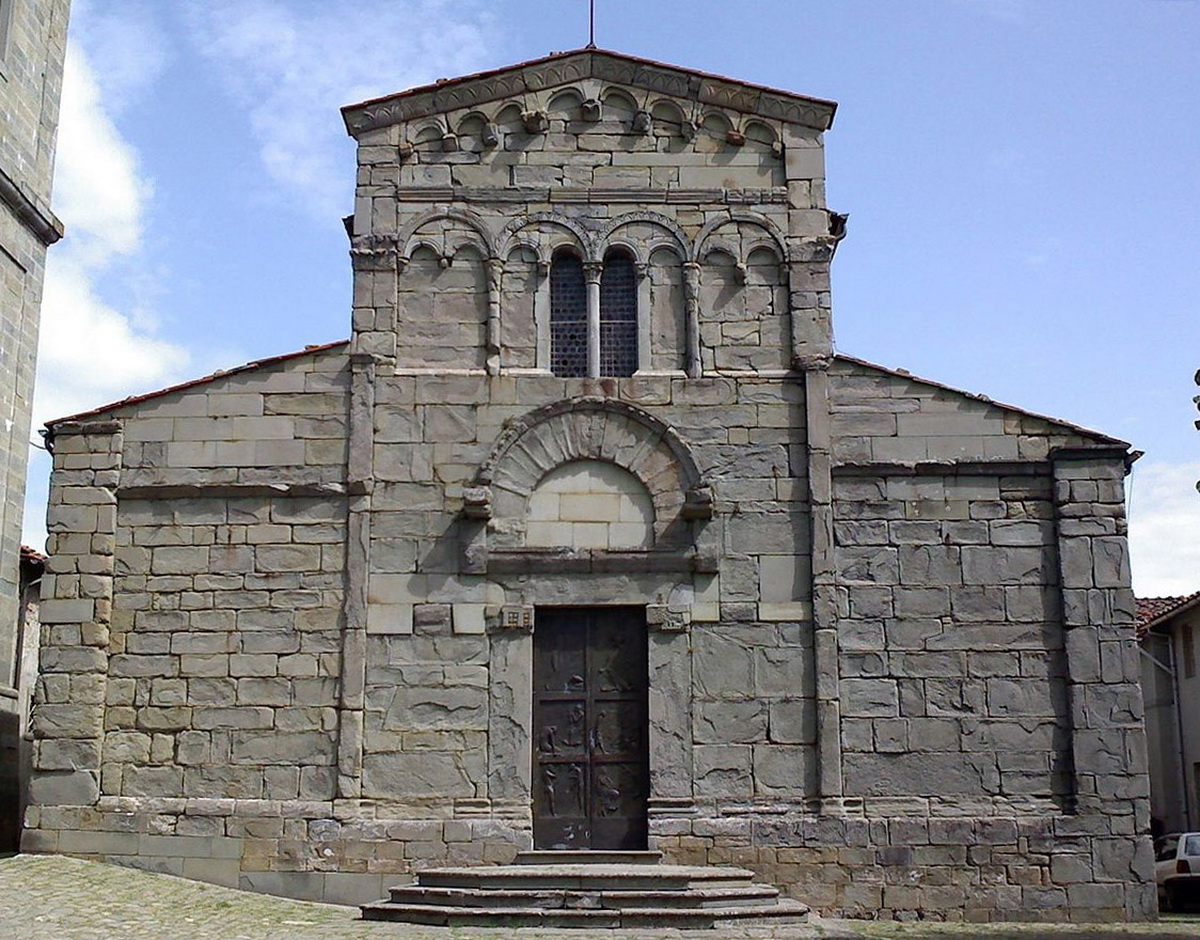
The structure has three naves and three apses (only the one on the left remains), and has numerous elements of reconstruction on the facade: the cubic capitals of the portal and the loggia of the upper order are original. Along the northern side there is the motif of hanging arches on shelves with a varied decorative repertoire, also replicated in the corbels of the apse area and, inside, in the two capitals of the columns on the counter-façade. The parish church of San Gennaro has become famous in recent times for the attribution to Leonardo da Vinci of a terracotta statue kept inside the church, depicting the Archangel Gabriel.
Ten small villages called Castella, all facing south and fortified by solid walls and towers, form this unique area of the Pistoia Apennines, formerly called Valleriana and today known as Switzerland Pesciatina. The first to coin this definition was Jean Charles Leonard Simonde de Sismondi, a historian and scholar from the city of Geneva who spent long periods staying there in the residence of some of his relatives. The comparison of the economic aspects of the Val di Nievole and even more of the landscape aspects of these valleys crossed by the two rivers with the green mountains, make them appear decidedly similar to those of the Confederation.
Vellano is historically the capital of this region where the presence of numerous waterways has made the valley a suitable place for the establishment of paper production activities, a driving economy for a long time. The area is part of the Via della carta, an ideal path that connects technology, culture and tradition. Five centuries of history are represented in a real widespread museum of industrial archeology, while some paper mills have been recovered and partially transformed into original tourist accommodation facilities. (www.laviadellacarta.it). In addition to the more famous one in Pescia, a beautiful Paper Museum is located in the Castella di Pietrabuona; there are documents showing the ancient manufacturing techniques and explaining the different uses of production, even on unusual occasions such as the production of papier-mâché used in the making of the famous floats of the Viareggio Carnival.
For more information: http://www.pescia.it/svizzera_pesciatina.htm
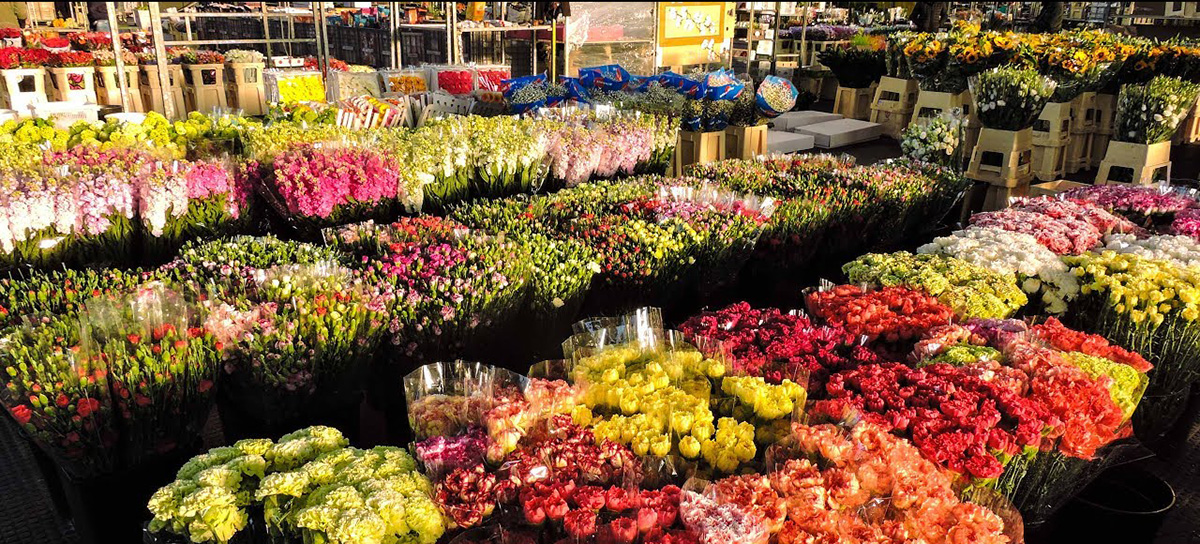
The flowers make us think about Sanremo, a city that benefits from a climate more favorable to that of Pescia but, nevertheless, it is here that, together with Pistoia, the largest cultivation sector of ornamental plants and cut flowers in all of Italy is realized. One of Pescia’s specializations is the cultivation of Gerberas, a flower similar to a large daisy with beautiful colors.
The beginning of flower cultivation is unique: mulberry trees have been cultivated here since the Middle Ages, necessary for the nourishment of silkworms. It is believed that the silkworm arrived in Europe thanks to a missionary monk from Pescia who hid it in his staff on his return from distant China, then the only producer of the precious yarn.
In the city there are two Flower Markets: the Old Market, in a rationalistic style, built in the 1950s which proved insufficient and now undergoing renovation and the other, which came into operation in 1988 and is called the New Market: a glass block building and steel, very particular, which aroused controversy for the particular style.
The community of Pescia is thinking about its future: the town is home to the Dionisio Anzilotti State Agricultural Technical Institute, which is responsible for training the new agricultural technicians needed to maintain and advance the nursery and horticultural tradition.
